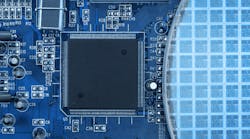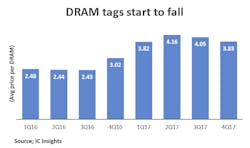DRAM prices have been increasing for about a year, but the good news for semiconductor buyers is that average selling prices have probably peaked and will begin to fall in the second half of the year.
Brian Matas, vice president of market research for IC Insights, based in Scottsdale, Ariz., said prices had increased because DRAM manufacturers’ production capacity was “maxed out” and demand was steady. The average price for a DRAM increased from $2.44 in the second quarter of 2016 to $4.16 in the second quarter of 2017, according to IC Insights.
“The strongest portion of DRAM price growth has taken place,” says Matas. “Right now is the peak of DRAM pricing. We are forecasting cooling DRAM average selling prices for the third and fourth quarters.”
However, prices will stay high compared to early 2016. The price will fall to $4.05 in the third quarter and to $3.83 in the fourth, the researcher said. It is uncertain when or if the average price will fall to the second quarter 2016 level of $2.44 because the DRAM market will remain tight.
“We are in a shortage,” says Jim Handy, founder and general director of research firm Objective Analysis, based in Los Gatos, Calif. “Once a shortage begins, it usually lasts about two years. The current shortage started about mid-year 2016, so it should go to mid-year 2018.” As a result, prices probably will not fall to second quarter 2016 levels anytime soon.
But prices will likely fall incrementally over the next several quarters because lower prices are necessary if manufacturers want to increase DRAM bit shipments. “Buyers are starting to balk a little bit, saying, ‘if the prices to continue to go up, then we will keep our DRAM content at a certain level and not add more until the prices come down a little bit more,’” says Matas.
In fact, DRAM manufacturers will increase production, which will result in lower prices. For instance, Samsung plans to begin production at a new fab in South Korea that will produce 300,000 wafers per month when the five reaches production capacity. The fab is expected to open in July, according to Matas.
Other DRAM manufacturers are increasing output by transitioning to sub-20nm process technology. Most advanced DRAM production is in the 20nm-25nm range. For instance, SK Hynix uses 21nm node and Micron uses 20nm. Samsung has been using 18nm technology for some production.
The transition to sub-20nm technology will mean that DRAM makers will get more die per wafer, so supply will increase and manufacturers can reduce prices while maintaining margins.
Micron, based in Boise, Idaho, also plans to improve cost efficiency and DRAM production by having DRAM fabrication and assembly and test in one facility in Taiwan. The company recently acquired the back-end operations of Cando Corp., adjacent to Micron’s existing Taichung fab and will centralize the company’s fabrication and back-end operations together in one location.
“Bringing fabrication and back-end together, all in one location, builds an efficient support structure for end-to-end manufacturing with quicker cycle times,” says Wayne Allan, vice president of global manufacturing for Micron.
The back-end site for assembly and test is expected to begin production in August and will bring greater operational cost efficiency for Micron’s DRAM production, the company said.
DRAM output will also increase in the future as memory IC manufacturers transition to 3D NAND flash from planar NAND. “When 3D NAND flash becomes dominant, then an awful lot of planar NAND capacity is going to be poised to be converted to DRAM capacity,” says Handy. “There will be more DRAM output.”










